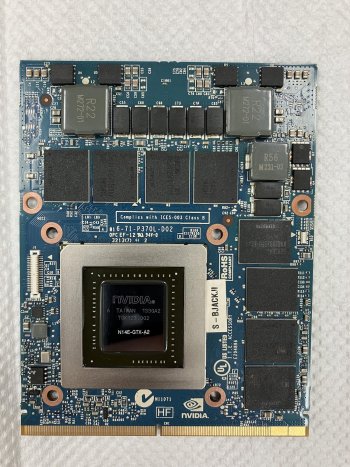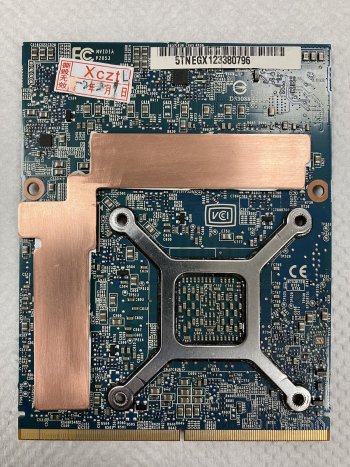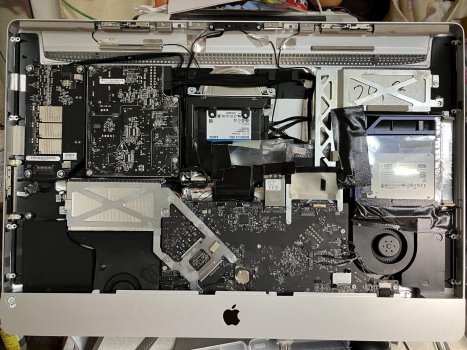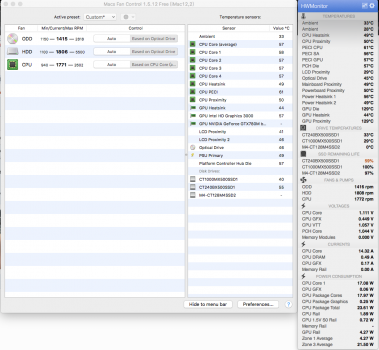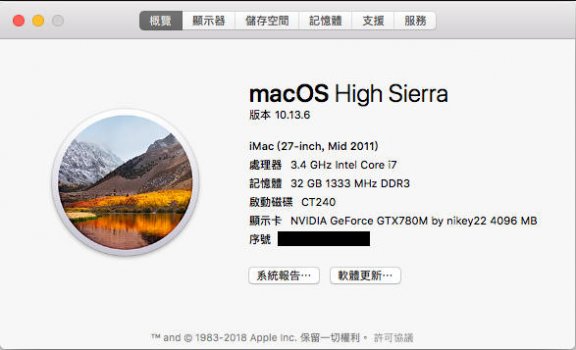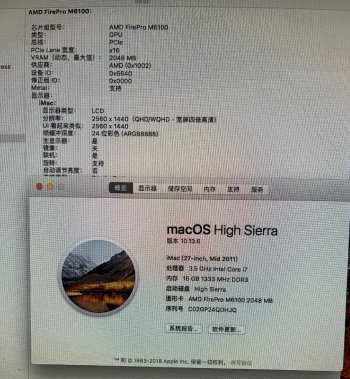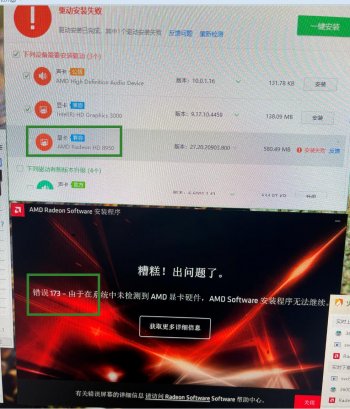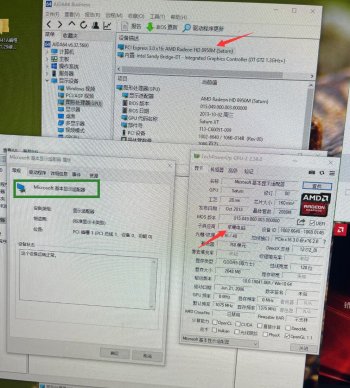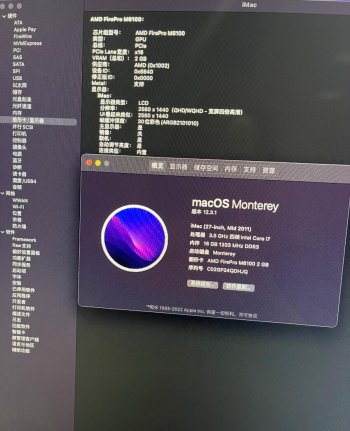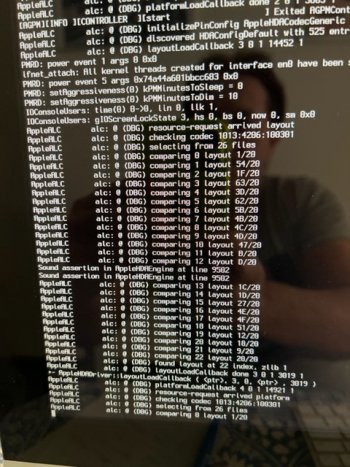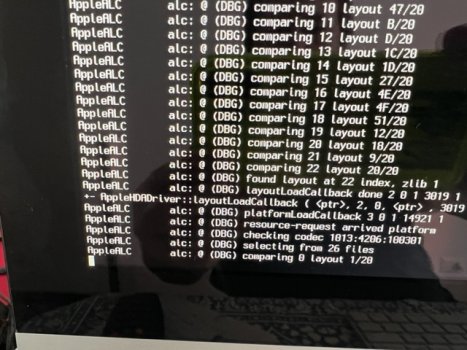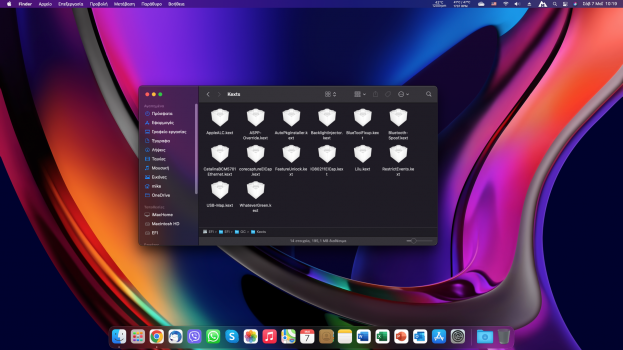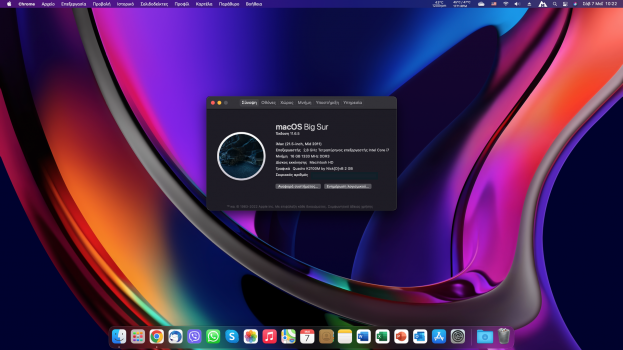Nope, wan't using external HDD/SSD (but that's good to know for future reference) - internal regular sata SSD and, I erased it clean. No, I think the issue is with the OCLD config.plist build for a target platform. Again, I have that original config.plist so I'll restore it and see if the re-install fails again (which it should).Have the same method, multiple OC folders with different names within the single EFI folder - mostly development versions. But when you posted the picture I knew you were using the wrong OC config and I asked....
Regarding the "firmware update needed" error message I guess you try to install to an external disk connected either via FireWire or USB3/Thunderbolt dock - both will not work. You can only boot from such devices already installed macOS versions (using OpenCore and the extensions provided). But you cannot install, the installer quits with messages like this.
Got a tip for us?
Let us know
Become a MacRumors Supporter for $50/year with no ads, ability to filter front page stories, and private forums.
iM 4,1-14,4 2011 iMac Graphics Card Upgrade
- Thread starter MichaelDT
- WikiPost WikiPost
- Start date
- Sort by reaction score
You are using an out of date browser. It may not display this or other websites correctly.
You should upgrade or use an alternative browser.
You should upgrade or use an alternative browser.
- Status
- The first post of this thread is a WikiPost and can be edited by anyone with the appropiate permissions. Your edits will be public.
During the last months I did not try the target method since I have all models here (unfortunately). So I cannot confirm your problems.Nope, wan't using external HDD/SSD (but that's good to know for future reference) - internal regular sata SSD and, I erased it clean. No, I think the issue is with the OCLD config.plist build for a target platform. Again, I have that original config.plist so I'll restore it and see if the re-install fails again (which it should).
But I have a small High Sierra SSD with the recent OCLP app to boot from and to use it as a starting point. This way I do not depend on any remotely generated configurations and I fully use the hardware detection capabilities OCLP offers. Normally I replace the BT/WiFi device and it will be detected, too.
Once in a while I am using the very same SSD to update the firmware, no old iMac I got came with the most recent version.
So, I know the answer but perhaps you know better - firmware question. Slightly off subject here but is important for video card replacement.During the last months I did not try the target method since I have all models here (unfortunately). So I cannot confirm your problems.
But I have a small High Sierra SSD with the recent OCLP app to boot from and to use it as a starting point. This way I do not depend on any remotely generated configurations and I fully use the hardware detection capabilities OCLP offers. Normally I replace the BT/WiFi device and it will be detected, too.
Once in a while I am using the very same SSD to update the firmware, no old iMac I got came with the most recent version.
If I have an older iMac with video card failing but it still boots and is currently running like El Capitan, often the firmware is old. I want this iMac to be running the latest firmware so I MUST flash that firmware while the original card is installed, right? If I replace the bad video card with OCLP only card then the actual firmware flash will be done "blindly" (black screen only because no boot video backlight support without OCLP)? Apple automatically flashes firmware on OS X install/update and this sucks, but it can be done without OS upgrade (I have a library of firmware roms). But it doesn't matter the reboot/upgrade would be blind, right?
You can search through Macrumors and may possibly find another way, but I stick with installing it through the High Sierra updates. When installing other firmware dumps you copy the other serial/hardware ID with it and you may cause trouble when using iCloud services, no good idea. You may dig deep into the details of firmware modding to change those values to the ones came with the real hardware you are dealing with. But I will not start a discussion about it here.So, I know the answer but perhaps you know better - firmware question. Slightly off subject here but is important for video card replacement.
If I have an older iMac with video card failing but it still boots and is currently running like El Capitan, often the firmware is old. I want this iMac to be running the latest firmware so I MUST flash that firmware while the original card is installed, right? If I replace the bad video card with OCLP only card then the actual firmware flash will be done "blindly" (black screen only because no boot video backlight support without OCLP)? Apple automatically flashes firmware on OS X install/update and this sucks, but it can be done without OS upgrade (I have a library of firmware roms). But it doesn't matter the reboot/upgrade would be blind, right?
No, there is no need to have the original card installed. First I own various replacement GPU cards with a working EFI boot screen and so I do not have to do it blindly, but even the GOP vBIOS cards needing OCLP black out only during the firmware update part, not during the normal macOS installation or update process. The last iMac12.2 I updated to 87.0.0.0.0 had a M5100 installed during the process.
No, there is no need to have the original card installed. First I own various replacement GPU cards with a working EFI boot screen and so I do not have to do it blindly, but even the GOP vBIOS cards needing OCLP black out only during the firmware update part, not during the normal macOS installation or update process. The last iMac12.2 I updated to 87.0.0.0.0 had a M5100 installed during the process.
Sorry, yes the GOP vBIOS cards that require OCLP boot WILL "black out during the firmware update" and that's my question. Having an EFI boot video card you can "see" the firmware upgrade finish, well not really finish but see the reboot. What you are saying is the firmware upgrade will complete fine with the display black, and reboot as expected. That's what I wanted to hear. I didn't want to replace a video card, install a new OS and have a firmware upgrade fail. That means re-solder on a replacement bios chip. I've done this already on MacBooks but not on a iMac.
Thank you.
the board I bought worked perfectly, I didn't need to add anything between the heatsink and the graphics processor, I just had to put a thermal pad over the memories, but I was worried about the memories on the other side of the board, but I believe they shouldn't get so hot. Remembering that my video card is the red one from Dell.Thanks for sharing. May I ask if need remote SSH to flash the VBios ? And did you also perform the "special install" with an additional copper plate to bridge the gap between sink and GPU chip or just go with the original heatsink?
Thank you for your kindly reply. I already return it to the seller and buy another 780m from a different seller. He flashed VBIO for me and it works fine except backlight control.
After replace GPU, CPU fan run with full speed when OS sleep. So I reset PRAM and CPU fan rpm become normal. Hope this info is useful for others.
Now I'm trying to upgrade to mojave. Hope everything will be fine!
Attachments
So if I upgrade from hd6970 to k2100m, i'll dont need to change the x clampEach different X-Clamp presents its own problems:
The NVIDIA X-Clamp fits the MXM card correctly, but the rivets are too small for the screws. If you remove the rivets by either drilling OR tapping them out, you're good.
The Radeon X-Clamp fits the screws perfectly, but it's a bit large for the NVIDIA cards and covers up and can damage resistors and a few capacitors on the back of the card. The areas around those need to be ground away in order for it to fit the NVIDIA card correctly.
I've always just drilled the NVIDIA card, seemed much easier to me - much less risk for me to screw up and hurt the GPU.
The heatsink mod needs to be done regardless of the X-Clamp you're doing - you could certainly do that by hand, but it might take some time. Apologies, I forgot the heatsink also needs grinding on the MXMb cards. I've only ever installed MXMa in mine.
Juste use the old one ? That 's right ?
The imac 2011 27" i7 can support more t'hab 16gb of ram ? You use 4x8gb?Thank you for your kindly reply. I already return it to the seller and buy another 780m from a different seller. He flashed VBIO for me and it works fine except backlight control.
After replace GPU, CPU fan run with full speed when OS sleep. So I reset PRAM and CPU fan rpm become normal. Hope this info is useful for others.
Now I'm trying to upgrade to mojave. Hope everything will be fine!
Another successful upgrade of an iMac 21.5 mid 2011 with a Dell WX4130 and i7 2600S!
Only minor issues in the documentation on first page, in that no copper shim was needed and both the hard drive, ssd and CD-ROM could stay connected and the Windows installer worked fine anyway, as the documentation on the first page suggested otherwise, but maybe that was an older Windows installer, this was Windows 10 21H2.
One major issue though, is that as soon as I install drivers for the graphics card in Windows 10 the display goes wonky.
Managed to trace it down to my Kanex thunderbolt to USB3/esata adapter, if I unplug it and reboot, Windows works fine. Didn't think anybody else had that problem since it's not mentioned in the documentation on the first page or in OCLP's documentation, but managed to find one other in this thread: https://forums.macrumors.com/threads/2011-imac-graphics-card-upgrade.1596614/post-29703985
So the question is if anybody (4130 GOP rom creator, OCLP developers) knows why this happens and if it can be fixed, either in the GOP rom, OCLP or some magic settings in the Windows registry?
Other than that, the iMac works just fine running Monterey 12.3.1
Oh by the way, I'm running OCLP 0.4.3.
Only minor issues in the documentation on first page, in that no copper shim was needed and both the hard drive, ssd and CD-ROM could stay connected and the Windows installer worked fine anyway, as the documentation on the first page suggested otherwise, but maybe that was an older Windows installer, this was Windows 10 21H2.
One major issue though, is that as soon as I install drivers for the graphics card in Windows 10 the display goes wonky.
Managed to trace it down to my Kanex thunderbolt to USB3/esata adapter, if I unplug it and reboot, Windows works fine. Didn't think anybody else had that problem since it's not mentioned in the documentation on the first page or in OCLP's documentation, but managed to find one other in this thread: https://forums.macrumors.com/threads/2011-imac-graphics-card-upgrade.1596614/post-29703985
So the question is if anybody (4130 GOP rom creator, OCLP developers) knows why this happens and if it can be fixed, either in the GOP rom, OCLP or some magic settings in the Windows registry?
Other than that, the iMac works just fine running Monterey 12.3.1
Oh by the way, I'm running OCLP 0.4.3.
Yes, 4*8gb is compatible. But I suggest you choosing 5V ram instead of 3.3V to prevent low voltage problem.The imac 2011 27" i7 can support more t'hab 16gb of ram ? You use 4x8gb?
Last edited:
Yes it's compatible with ddr3 (not ddr3l)Yes, 4*8gb is compatible. But I suggest you choosing 5V ram instead of 3.3V to invent low voltage problem.
Thanks for the information
Code:
panic(cpu 0 caller 0xffffff800ce2c081): AMDFramebufferCI::setPowerState(0xffffff99b7dc6800 : 0xffffff7fa5758892, 0 -> 2) timed out after 45356 ms @IOServicePM.cpp:5524
Panicked task 0xffffff99b8650670: 206 threads: pid 0: kernel_task
Backtrace (CPU 0), panicked thread: 0xffffff8685e37aa8, Frame : Return Address
0xffffffd06622ba30 : 0xffffff800c683e2d mach_kernel : _handle_debugger_trap + 0x41d
0xffffffd06622ba80 : 0xffffff800c7e3cb6 mach_kernel : _kdp_i386_trap + 0x116
0xffffffd06622bac0 : 0xffffff800c7d350d mach_kernel : _kernel_trap + 0x51d
0xffffffd06622bb10 : 0xffffff800c623a60 mach_kernel : _return_from_trap + 0xe0
0xffffffd06622bb30 : 0xffffff800c6841fd mach_kernel : _DebuggerTrapWithState + 0xad
0xffffffd06622bc50 : 0xffffff800c6839b6 mach_kernel : _panic_trap_to_debugger + 0x2b6
0xffffffd06622bcb0 : 0xffffff800cf164bf mach_kernel : _panic + 0x84
0xffffffd06622bda0 : 0xffffff800ce2c081 mach_kernel : __ZN9IOService12ackTimerTickEv + 0x801
0xffffffd06622be00 : 0xffffff800ce2b849 mach_kernel : __ZN9IOService21actionAckTimerExpiredEP8OSObjectPvS2_S2_S2_ + 0x9
0xffffffd06622be10 : 0xffffff800ce45bae mach_kernel : __ZN10IOWorkLoop9runActionEPFiP8OSObjectPvS2_S2_S2_ES1_S2_S2_S2_S2_ + 0x3e
0xffffffd06622be50 : 0xffffff800ce2a668 mach_kernel : __ZN9IOService17ack_timer_expiredEPvS0_ + 0x38
0xffffffd06622be70 : 0xffffff800c6d71f5 mach_kernel : _thread_call_delayed_timer + 0x505
0xffffffd06622bee0 : 0xffffff800c6d82c2 mach_kernel : _thread_call_delayed_timer + 0x15d2
0xffffffd06622bfa0 : 0xffffff800c62318e mach_kernel : _call_continuation + 0x2e
Process name corresponding to current thread (0xffffff8685e37aa8): kernel_task
Boot args: keepsyms=1 debug=0x100 -disable_sidecar_mac -v -revasset
Mac OS version:
21E258
Kernel version:
Darwin Kernel Version 21.4.0: Fri Mar 18 00:45:05 PDT 2022; root:xnu-8020.101.4~15/RELEASE_X86_64
Kernel UUID: B6F8637B-0844-355F-8C82-60FA06149384
KernelCache slide: 0x000000000c400000
KernelCache base: 0xffffff800c600000
Kernel slide: 0x000000000c410000
Kernel text base: 0xffffff800c610000
__HIB text base: 0xffffff800c500000
System model name: iMacPro1,1 (Mac-7BA5B2D9E42DDD94)
System shutdown begun: NO
Panic diags file available: YES (0x0)
Hibernation exit count: 0
System uptime in nanoseconds: 6573378460097
Last Sleep: absolute base_tsc base_nano
Uptime : 0x000005fa7be3626a
Sleep : 0x000005efc76f6b19 0x00000000415b3932 0x000005184f63c038
Wake : 0x000005efd81f0f30 0x00000000415168cc 0x000005efd70dfce9
Compressor Info: 1% of compressed pages limit (OK) and 2% of segments limit (OK) with 1 swapfiles and OK swap space
Zone info:
Foreign : 0xffffff80120e3000 - 0xffffff80120f1000
Native : 0xffffff801ecd2000 - 0xffffffa01ecd2000
Readonly: 0xffffff84eb99e000 - 0xffffff8685337000
Metadata: 0xffffffec46efb000 - 0xffffffec66fc7000
Bitmaps : 0xffffffec66fc7000 - 0xffffffec69fc7000I have a W6170M installed in my 12,2. I haven't start to use it much but it has been sitting on and idle for the past week and I noticed the screen wasn't waking up today. I have actual sleep disabled since I know GCN and the 2011 iMacs have a conflict. Any ideas what might have caused the crash?
Apparently the iMac was sleeping and crashed on wake.Code:panic(cpu 0 caller 0xffffff800ce2c081): AMDFramebufferCI::setPowerState(0xffffff99b7dc6800 : 0xffffff7fa5758892, 0 -> 2) timed out after 45356 ms @IOServicePM.cpp:5524 Panicked task 0xffffff99b8650670: 206 threads: pid 0: kernel_task Backtrace (CPU 0), panicked thread: 0xffffff8685e37aa8, Frame : Return Address 0xffffffd06622ba30 : 0xffffff800c683e2d mach_kernel : _handle_debugger_trap + 0x41d 0xffffffd06622ba80 : 0xffffff800c7e3cb6 mach_kernel : _kdp_i386_trap + 0x116 0xffffffd06622bac0 : 0xffffff800c7d350d mach_kernel : _kernel_trap + 0x51d 0xffffffd06622bb10 : 0xffffff800c623a60 mach_kernel : _return_from_trap + 0xe0 0xffffffd06622bb30 : 0xffffff800c6841fd mach_kernel : _DebuggerTrapWithState + 0xad 0xffffffd06622bc50 : 0xffffff800c6839b6 mach_kernel : _panic_trap_to_debugger + 0x2b6 0xffffffd06622bcb0 : 0xffffff800cf164bf mach_kernel : _panic + 0x84 0xffffffd06622bda0 : 0xffffff800ce2c081 mach_kernel : __ZN9IOService12ackTimerTickEv + 0x801 0xffffffd06622be00 : 0xffffff800ce2b849 mach_kernel : __ZN9IOService21actionAckTimerExpiredEP8OSObjectPvS2_S2_S2_ + 0x9 0xffffffd06622be10 : 0xffffff800ce45bae mach_kernel : __ZN10IOWorkLoop9runActionEPFiP8OSObjectPvS2_S2_S2_ES1_S2_S2_S2_S2_ + 0x3e 0xffffffd06622be50 : 0xffffff800ce2a668 mach_kernel : __ZN9IOService17ack_timer_expiredEPvS0_ + 0x38 0xffffffd06622be70 : 0xffffff800c6d71f5 mach_kernel : _thread_call_delayed_timer + 0x505 0xffffffd06622bee0 : 0xffffff800c6d82c2 mach_kernel : _thread_call_delayed_timer + 0x15d2 0xffffffd06622bfa0 : 0xffffff800c62318e mach_kernel : _call_continuation + 0x2e Process name corresponding to current thread (0xffffff8685e37aa8): kernel_task Boot args: keepsyms=1 debug=0x100 -disable_sidecar_mac -v -revasset Mac OS version: 21E258 Kernel version: Darwin Kernel Version 21.4.0: Fri Mar 18 00:45:05 PDT 2022; root:xnu-8020.101.4~15/RELEASE_X86_64 Kernel UUID: B6F8637B-0844-355F-8C82-60FA06149384 KernelCache slide: 0x000000000c400000 KernelCache base: 0xffffff800c600000 Kernel slide: 0x000000000c410000 Kernel text base: 0xffffff800c610000 __HIB text base: 0xffffff800c500000 System model name: iMacPro1,1 (Mac-7BA5B2D9E42DDD94) System shutdown begun: NO Panic diags file available: YES (0x0) Hibernation exit count: 0 System uptime in nanoseconds: 6573378460097 Last Sleep: absolute base_tsc base_nano Uptime : 0x000005fa7be3626a Sleep : 0x000005efc76f6b19 0x00000000415b3932 0x000005184f63c038 Wake : 0x000005efd81f0f30 0x00000000415168cc 0x000005efd70dfce9 Compressor Info: 1% of compressed pages limit (OK) and 2% of segments limit (OK) with 1 swapfiles and OK swap space Zone info: Foreign : 0xffffff80120e3000 - 0xffffff80120f1000 Native : 0xffffff801ecd2000 - 0xffffffa01ecd2000 Readonly: 0xffffff84eb99e000 - 0xffffff8685337000 Metadata: 0xffffffec46efb000 - 0xffffffec66fc7000 Bitmaps : 0xffffffec66fc7000 - 0xffffffec69fc7000
I have a W6170M installed in my 12,2. I haven't start to use it much but it has been sitting on and idle for the past week and I noticed the screen wasn't waking up today. I have actual sleep disabled since I know GCN and the 2011 iMacs have a conflict. Any ideas what might have caused the crash?
You cannot even use the Finder menu sleep even with system sleep being disabled in the system preferences.
It will nevertheless send the system to sleep and from this it will not wake. Since I do not really know any solution right now just do not install and use this card in the iMac12,2.
So when you say loaded by the card do you mean that after replacing the eeprom it still wont flash? even though the eeprom is detected by ati flash etc. ?
I'll follow up and let you know how the install goes when i get to it hopefully this week.
the front and back pictures are on my first post here:

2011 iMac Graphics Card Upgrade
Hi, having issues with a "Dell" AMD FirePro M4000 1GB. I include pictures for ID. I've tried to flash this in both an imac 27" 2011, headless with the bootable linux image on this thread and on my Xserve 3.1 in windows 10. The error i receive is Error: 0FL01. After another restart and another...forums.macrumors.com
Not sure if you got around to testing it, but if you have, what was the result?
In my case, VBIOS wasn't detected and I more-or-less did exactly what you did, so I'm looking forward to knowing if your result was different than mine.
Hi @nikey22 @AusdauersportlerExperimental AMD FirePro M6100 2GB (AMD R9 M380)
View attachment 1876272
This thread will chronicle my efforts to get the AMD FirePro M6100 MXM 3.0 card working on a 2009/2010 iMac. I've been working on it for several months. I will concentrate on the older iMacs as the 2011 iMacs have an issue with the "wake" cycle not recognizing the GPU and make this card nearly unusable.
This card is used internally in a iMac (Retina 5K, 27-inch, Late 2015), model Identifier: iMac17,1
SSH Access:
Code:Adapter 0 SEG=0000, BN=01, DN=00, PCIID=66401002, SSID=00000000) Asic Family : Bonaire Flash Type : M25P10/c (128 KB) Product Name : Dell / Compal Brooks Saturn XT C60001 A1 GDDR5 2GB 300e/150m <-- card recognized! Bios Config File : BR44933.001 Bios P/N : P/N Not Available Bios Version : 015.040.000.001.044933 Bios Date : 10/02/13,10:35:3 ROM Image Type : Hybrid Images ROM Image Details : Image[0]: Size(65024 Bytes), Type(Legacy Image) <-- legacy vbios recognized! Image[1]: Size(61440 Bytes), Type(EFI Image) <-- PCI option ROM/UEFI recognized!
MacOS integration:
This card uses the AMD8000Controller.kext and the AMDBonaireGraphicsAcccelerator - RadeonX4000.kext which also natively runs in MacOS. The AMDMTLBronzeDriver is used to initialize its Metal capability. The default framebuffer is in use: RadeonFrameBuffer.
You will like need to apply the same Device Properties as previously stated in other posts <@Ausdauersportler> here recently.
Mods:
- I modified the OBJ table to work with our current iMac models: eDP:14, EncoderID:21, I2CID:92, SenseID:03.
- I used the IM17,1 Header to trick AppleGraphicsPolicy into accepting it as native
- I used an IM17,1 VGA bootloader firmware instead of the stock Dell one and adjusted the pointer to the parser-fall-call in the TVdispout table to point to the correct area in the patched bootloader.
- I used a PC UEFI GOP to communicate with OC and/or OCLP, so you will not get a native MacOS boot picker screen, but instead the OC one.
- GPIO_Pin_LUT has 6 pin assignments for Dell ROM, there are 8 defined in the Apple ROM. This was patched.
- In EFI 1.x systems, the INT 10H and the VESA BIOS Extensions (VBE) are replaced by the EFI UGA protocol. In the more widely used UEFI 2.x systems, the INT10H and the VBE are replaced by the UEFI GOP which is what we are using here to communicate with OpenCore or OCLP using device properties.
The card is recognized as an 'HD8xxx', but that doesn't matter. With the proper OperCore config file, it should be recognized appropriately. I have only tested with High Sierra and Catalina:
View attachment 1876252
View attachment 1876257
Thermal IC chip:
The SMC "0" SMBus Connections on the iMac uses a write address of: 0x98 for the 8-bit SMC slave address. This is equivalent to a 0x4C 7-bit slave address:
Code:0x98 = 1001 1000 0x4C = 0100 1100 (you can see that the 7-bit address is just bit-shifted to the right by 1)
So a GPU card with a ADM1032 thermal IC with a part marking "T1J" seems to work because it communicates on the 0x4C SMC address and will not cause an address collision with other thermal ICs on the logic board. In contrast, an ADM1032 chip with a part marking "T1C" is internally connected to 0x4D and therefore will not communicate with the imac SMC. An EMC1402-1 chip has a slave address of 1001_100 (corresponding to 7-bit 0x4C) and theoretically should also work, but there could be other interactions that are interfering with this. More investigation is necessary.
10/25/2021 addendum:
@dfranetic has pointed out correctly that the SMC information is not being read correctly by this chip, ADM1032. It appears that Mac Fan Control queries the thermal IC directly and not the SMC lane. So back to the drawing board! Sometimes sounds theories don't turn out as we expect in reality
Here is Macs Fan Control:
View attachment 1876141
Let's take a closer look at this IC:
View attachment 1876140
You can see here, that it uses 2 Jumper resistors (lime green) to connect the SCL and SDA lines to the GPU. The pull up resistors are right next to them, both are 100KOhm I believe. I will as an experiment remove these 0 Ohm resistors and see what happens to the GPU temp read out, stay tuned. More research here is necessary.
Benchmark:
View attachment 1876142
Other members have been working on variants of this card, but be warned, these are experimental in nature and still have a lot of troubleshooting to get them working appropriately. They are painful to recover from a bad flash. It's been a long frustrating road with these class of cards, but nevertheless, it has always been insanely great!
Enjoy.Addendum:
M6100_Elpida.rom - This is for M6100 cards with Elpida VRAM.
M6100 graphics card tested the three versions you provided, macos can be used also shows model M6100.
windows10 install driver failed gpu-z detects vendor information for apple, whether the hardware vendor ID is dell to properly match the installed driver.
windows check hardware model for HD8950M graphics card driver can not be installed properly can be corrected, m6100 hd8950m is the same card just driver difference thus showing the model difference.
Translated with www.DeepL.com/Translator (free version)
Übersetzt mit www.DeepL.com/Translator (kostenlose Version)
Attachments
Hi, is that the best WX4150 card, I will buy this one, just to checking whit doctors here
I cant access marketplace here, if someone here are selling one WX4150 just let me now, if is EU based better.

I cant access marketplace here, if someone here are selling one WX4150 just let me now, if is EU based better.
Thanks! The machine is still finding a way to sleep even though it’s disabled. I guess I’ll be grabbing one of the last 3 WX4150’s available in the US on eBay soon.Apparently the iMac was sleeping and crashed on wake.
You cannot even use the Finder menu sleep even with system sleep being disabled in the system preferences.
It will nevertheless send the system to sleep and from this it will not wake. Since I do not really know any solution right now just do not install and use this card in the iMac12,2.
Anyone who’d like a GOP flashed W6170M for their ‘09/‘10 machine, shoot me a PM.
Last edited:
Got a bit of a weird one.
I have a 2011 iMac 27" with the "3-pipe" gpu cooler.
The original GPU is, like so many, on its last legs after being "baked" twice already now.
I have both a K3100M and a 780m.
Both work in my older 2010 iMac 27", so I know nothing is wrong with them. Both boot perfectly, obviously without bootscreen.
As of course the 2011 is a better machine (with i7-2600) I would love to upgrade the GPU in that machine, maybe flash the firmware and get a more recent OS on it using OC.
However, neither of the cards gets recognized in the machine, third (GPU detected) and fourth (display detected) LED stay of, only the first two light up (with chime and the machine boots to the OS with black screen).
Any idea why the 2011 is so picky towards GPU's?
Kind of reluctant to buy any other card!
I have a 2011 iMac 27" with the "3-pipe" gpu cooler.
The original GPU is, like so many, on its last legs after being "baked" twice already now.
I have both a K3100M and a 780m.
Both work in my older 2010 iMac 27", so I know nothing is wrong with them. Both boot perfectly, obviously without bootscreen.
As of course the 2011 is a better machine (with i7-2600) I would love to upgrade the GPU in that machine, maybe flash the firmware and get a more recent OS on it using OC.
However, neither of the cards gets recognized in the machine, third (GPU detected) and fourth (display detected) LED stay of, only the first two light up (with chime and the machine boots to the OS with black screen).
Any idea why the 2011 is so picky towards GPU's?
Kind of reluctant to buy any other card!
Got a bit of a weird one.
I have a 2011 iMac 27" with the "3-pipe" gpu cooler.
The original GPU is, like so many, on its last legs after being "baked" twice already now.
I have both a K3100M and a 780m.
Both work in my older 2010 iMac 27", so I know nothing is wrong with them. Both boot perfectly, obviously without bootscreen.
Both cards have been already flashed with modded vBIOS?
If yes, then at least the K3100m is expected to have boot screen.
Hello everyone maybe my question was answered in the past and is a newbie one .. on my discharge i would say is not easy to dig thru 740 pages .. however this my question
I have an old imac 27 i7 2011 where i replaced years ago the gpu with a GeForce Kepler K1000 and installed Catalina
Now I would like to update to Big Sur but when I genereate the installer with oclp (tried different oclp and big sur versions)
i can boot into EFI but the install remain stuck with the last line diplaying waiting for ALC ... (or something which sounds similar)
Pictures include the step where it got stuck
Can someone give me an hint about how to proceed towards installing BigSur please
thanks
I have an old imac 27 i7 2011 where i replaced years ago the gpu with a GeForce Kepler K1000 and installed Catalina
Now I would like to update to Big Sur but when I genereate the installer with oclp (tried different oclp and big sur versions)
i can boot into EFI but the install remain stuck with the last line diplaying waiting for ALC ... (or something which sounds similar)
Pictures include the step where it got stuck
Can someone give me an hint about how to proceed towards installing BigSur please
thanks
Attachments
Last edited:
AppleALC has to do with the sound kext. I don't know if that helps. Maybe the kext is not the correct one and so the driver is conflicting. Fyi, I use an 2011 imac updated to Big Sur with a K2100m GPU using OCLP 0.4.4. My apple ALC kext is version 1.6.3.Hello everyone maybe my question was answered in the past and is a newbie one .. on my discharge i would say is not easy to dig thru 740 pages .. however this my question
I have an old imac 27 i7 2011 where i replaced years ago the gpu with a GeForce Kepler K1000 and installed Catalina
Now I would like to update to Big Sur but when I genereate the installer with oclp (tried different oclp and big sur versions)
i can boot into EFI but the install remain stuck with the last line diplaying waiting for ALC ... (or something which sounds similar)
Pictures include the step where it got stuck
Can someone give me an hint about how to proceed towards installing BigSur please
thanks
Whilst version 1.6.3 is not the latest one (I think 1.7.1 is the latest one), OCLP does not update it to the latest version, probably due to compatibility reasons. You can try downloading AppleALC version 1.6.3, replace the one you have in your EFI/OC/Kext folder and see if that helps. Maybe now you have an older AppleALC kext from your Catalina era and a more update one is needed for big sur.
OR there is another kext that needs to be removed. Check to see that you don't have any other conflicting kext with AppleALC like AppleHDAdisabler kext etc. I attach a pic of my kext folder for your reference. (In case you delete a kext, you need to also update the config.plist accordingly).
Release 1.6.3 · acidanthera/AppleALC
v1.6.3 Update ALC289 layout-id 87 by GitNaufal Update ALC235 layout-id 18 for AsRock 310 BB by viorel78
Attachments
Last edited:
I updated from an HD6770 to a K2100m (my iMac is mid 2011). I have not encountered any GPU issues. Ofcourse I also flashed the new recommended Bios by Nick[D]vB. What do you mean when you say "issues with the way graphics appear"? Can you explain or post a pic?Has anybody encountered any issue with the way graphics appear when upgrading the ATI Radeon HD 5750 1024 MB with an Nvidia K2100 GPU?
Attachments
Last edited:
Sorry, I’m new to this. Can anyone help.
I’m running Monterey 12.3.1 new install with Opencore 0.44
Graphics Quadro K2100M by nikey22 2GB
iMac12,2 (mid 2011)
8gb Ram
HDD replaced with SSD (fan controlled)
Everything works well except when I sleep the computer. Fans come on eventually kernel panics.
I bought the K2100m pre flashed. Does it need to be flashed with a different Bios or is just how K2100m works with iMac12,2?
Is there another plug and play card best suited for iMac12,2 (mid 2011)?
I’m running Monterey 12.3.1 new install with Opencore 0.44
Graphics Quadro K2100M by nikey22 2GB
iMac12,2 (mid 2011)
8gb Ram
HDD replaced with SSD (fan controlled)
Everything works well except when I sleep the computer. Fans come on eventually kernel panics.
I bought the K2100m pre flashed. Does it need to be flashed with a different Bios or is just how K2100m works with iMac12,2?
Is there another plug and play card best suited for iMac12,2 (mid 2011)?
Register on MacRumors! This sidebar will go away, and you'll see fewer ads.


